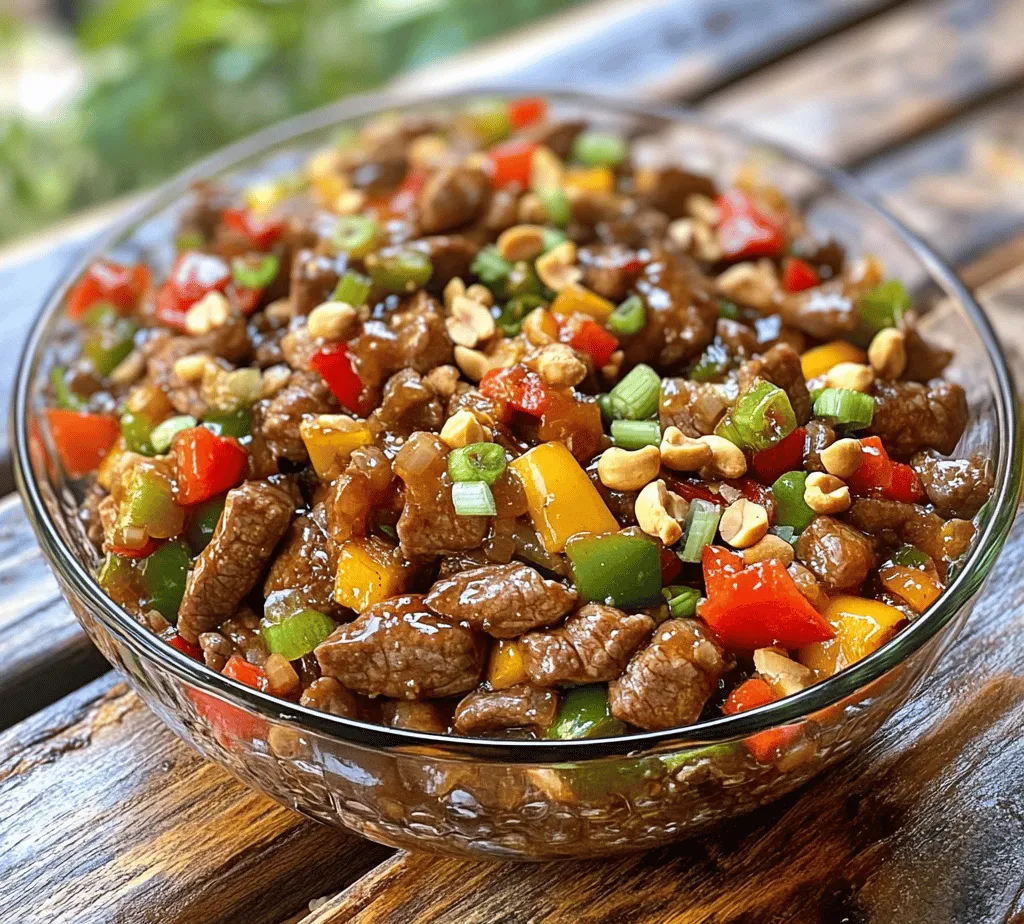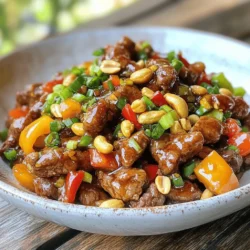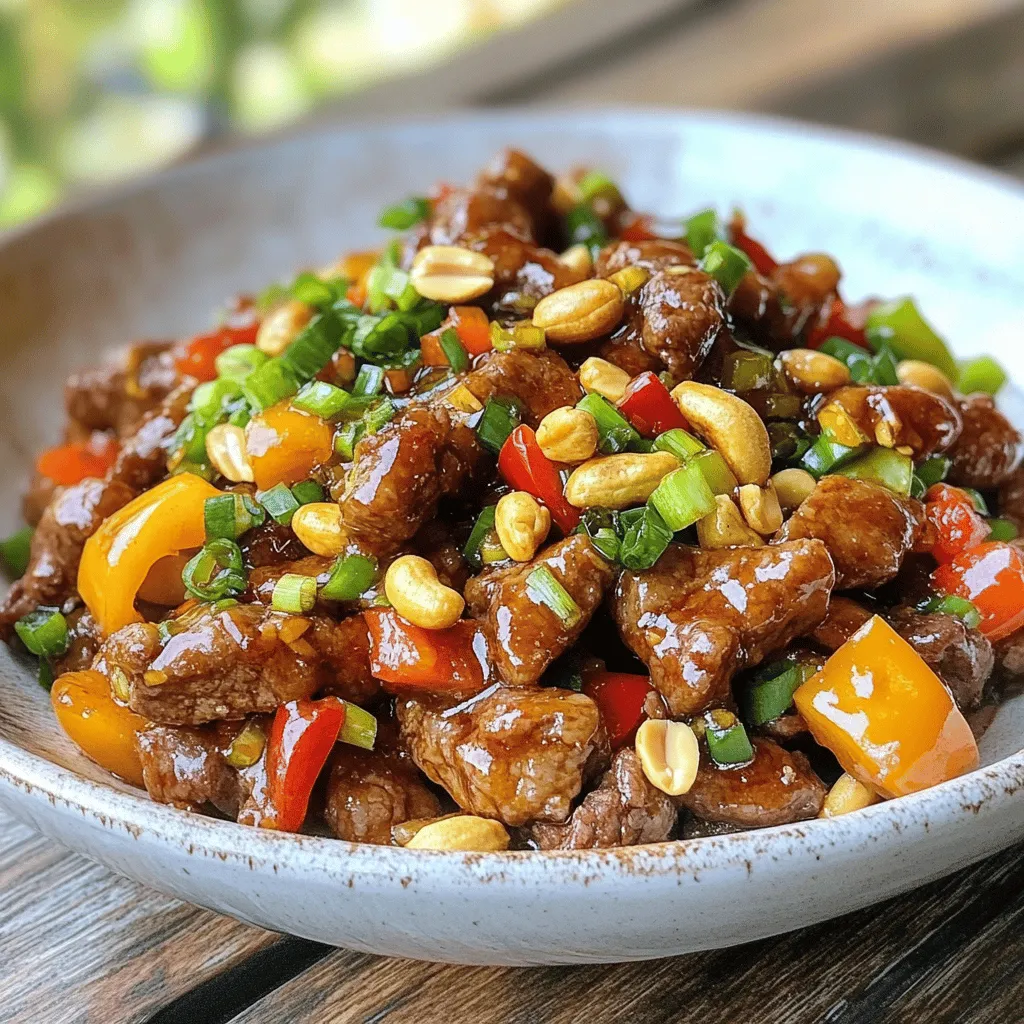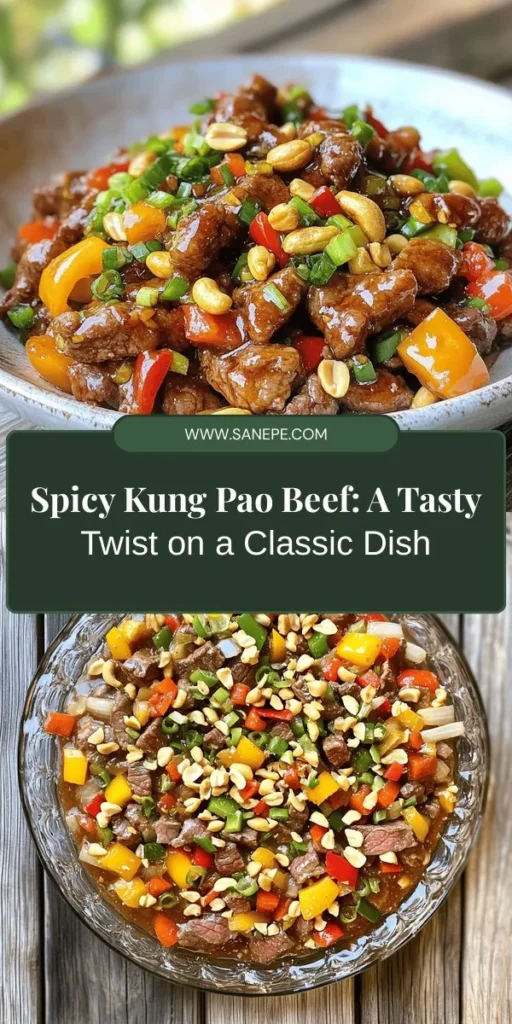Introduction
Kung Pao Beef is not just a dish; it’s a culinary experience that encapsulates the vibrant flavors of Chinese cuisine. Originating from the Sichuan province, this classic stir-fry has garnered a loyal following around the world. At the heart of its allure lies a harmonious blend of savory, spicy, and slightly sweet flavors, making it a staple in many Chinese restaurants and home kitchens alike.
In this article, we introduce you to a tantalizing twist on the traditional recipe: Spicy Kung Pao Beef Delight. This version amplifies the heat and complexity, appealing to those who crave a bit more excitement in their meals. Whether you’re hosting a dinner party or simply indulging in a cozy night in, this dish promises to deliver a burst of flavor that will leave your taste buds dancing. The Spicy Kung Pao Beef Delight is perfect for various occasions, as it is both impressive and easy to prepare, fitting seamlessly into any menu.
Understanding Kung Pao Beef
To truly appreciate Spicy Kung Pao Beef Delight, it’s essential to understand its rich history and cultural significance. The dish is named after Ding Baozhen, a 19th-century governor of Sichuan, whose nickname was “Kung Pao.” Originally, Kung Pao was made with diced chicken, but over the years, it has evolved into various versions featuring different proteins, including beef, shrimp, and even tofu, reflecting regional preferences and ingredient availability.
Historically, Kung Pao Beef emerged from the vibrant culinary traditions of Sichuan cuisine, known for its bold flavors and liberal use of spices. Sichuan cuisine is characterized by its incorporation of unique ingredients like Sichuan peppercorns, which lend a distinctive numbing spiciness, and dried red chili peppers that contribute both heat and color. As the dish traveled beyond its geographic origins, it adapted to local tastes and ingredients, leading to numerous variations across the globe. In Western adaptations, for example, the dish is often sweetened with additional sugar or served with a thickened sauce, while still retaining its essential components.
Kung Pao Beef has become a symbol of Chinese culinary prowess, showcasing the balance of flavors and the art of stir-frying. Its cultural significance extends beyond mere sustenance, as it represents the rich heritage of Sichuan cooking and the art of using spices to elevate a dish to new heights.
Ingredient Breakdown
Key Ingredients
The magic of Spicy Kung Pao Beef Delight lies in its carefully selected ingredients, each playing a crucial role in creating the dish’s signature flavor profile.
Beef Sirloin
At the heart of this dish is beef sirloin, a cut known for its tenderness and rich flavor. When preparing Kung Pao Beef, the choice of meat is paramount; sirloin provides the perfect balance of flavor and texture. To maximize tenderness, marinating the beef is essential. A simple marinade typically includes soy sauce, cornstarch, and a splash of rice wine, which not only enhances the flavor but also helps to break down the meat fibers, resulting in a more succulent bite.
Vegetables
Bell peppers and green onions are the stars of the vegetable lineup in this dish. Bell peppers add a sweet crunch that beautifully contrasts with the spicy elements, while green onions contribute a mild onion flavor and fresh aroma. Together, they create a vibrant medley that enhances both the visual appeal and the texture of the dish.
Sauces
The sauce is where the magic happens, and in Spicy Kung Pao Beef Delight, several key sauces come together to create a symphony of flavors.
– Soy Sauce: A cornerstone of Chinese cooking, soy sauce brings saltiness and depth.
– Rice Vinegar: This balances the dish with a hint of acidity, brightening the overall flavor.
– Hoisin Sauce: Often described as the “Chinese ketchup,” hoisin adds sweetness and a complex richness.
– Sesame Oil: This fragrant oil is used sparingly to impart a nutty flavor that rounds out the sauce beautifully.
Spices
No Kung Pao dish would be complete without its signature spices.
– Sichuan Peppercorns: These unique peppercorns provide a distinctive numbing sensation and a citrusy flavor that sets this dish apart. They are a hallmark of Sichuan cuisine and are responsible for the characteristic heat that many have come to love.
– Dried Red Chili Peppers: For those who revel in heat, dried red chili peppers are essential. They infuse the dish with fiery spice and are often tossed in whole, allowing diners to control the level of heat they desire.
Roasted Peanuts
Finally, the dish is crowned with roasted peanuts, which contribute a delightful crunch and rich, nutty flavor. These peanuts not only enhance the texture but also provide a satisfying contrast to the tender beef and crisp vegetables.
Preparation Steps
With a clear understanding of the ingredients that make Spicy Kung Pao Beef Delight shine, we can now delve into the preparation steps that will guide you toward creating this delicious dish in your own kitchen.
Step 1: Marinating the Beef
The first step in crafting this flavorful dish is marinating the beef. This is a crucial process that imparts flavor and tenderness to the meat.
1. Slice the Beef: Begin by slicing the beef sirloin against the grain into thin strips. This technique ensures that the meat remains tender and easy to chew.
2. Create the Marinade: In a bowl, combine the sliced beef with soy sauce, a teaspoon of cornstarch, and a splash of rice wine. The cornstarch will help to tenderize the meat while creating a silky texture when cooked.
3. Let It Rest: Allow the beef to marinate for at least 20 minutes. If you have more time, letting the beef marinate for up to an hour in the refrigerator will deepen the flavors.
Step 2: Preparing the Sauce
While the beef absorbs the flavors of the marinade, it’s time to prepare the sauce that will coat the stir-fried ingredients.
1. Mix the Sauce Ingredients: In a separate bowl, combine soy sauce, rice vinegar, hoisin sauce, and sesame oil. The balance of these ingredients is essential to achieving the right flavor profile. Taste the mixture and adjust the sweetness or acidity as desired.
2. Set Aside: Once mixed, set the sauce aside to allow the flavors to meld. This will enhance the overall taste of your dish when it’s time to combine everything.
With these preparation steps complete, you are well on your way to creating a flavorful Spicy Kung Pao Beef Delight. The next phase will involve cooking the beef and vegetables to perfection, ensuring each bite is an explosion of flavor. Stay tuned for the continuation of this recipe, where we will guide you through the cooking process and offer tips for achieving the best results.

Stir-Frying Techniques
Stir-frying is a cornerstone cooking technique in Chinese cuisine, and mastering it is essential for preparing the perfect Spicy Kung Pao Beef Delight. The key to successful stir-frying lies in high heat and quick cooking, which helps retain the vibrant colors and crisp textures of the ingredients.
Tips on Achieving the Perfect Sear and Avoiding Steaming
1. Preheat the Wok or Pan: Before adding any ingredients, ensure your wok or skillet is preheated until it begins to shimmer. This high temperature is crucial to achieving a proper sear on the beef.
2. Use the Right Oil: Opt for oils with a high smoke point, such as peanut oil or canola oil. This will help achieve that desirable sear without burning.
3. Don’t Overcrowd the Pan: When cooking the beef, work in batches if necessary. Overcrowding can lead to steaming rather than searing, which affects the texture of the meat.
4. Cut Uniformly: Ensure that the beef is cut into uniform pieces. This facilitates even cooking, helping you achieve the perfect doneness throughout.
5. Keep Ingredients Dry: Excess moisture from ingredients can cause them to steam instead of fry. Pat your beef and vegetables dry with a paper towel before cooking.
Cooking Process
This section provides a detailed walkthrough of the cooking stages for your Spicy Kung Pao Beef Delight, ensuring you achieve the best flavor and texture.
Stir-Frying the Beef and Ensuring Proper Doneness
1. Marinate the Beef: Begin by marinating your sliced beef in a mixture of soy sauce, cornstarch, and a touch of sesame oil for about 15-20 minutes. This not only tenderizes the meat but also infuses it with flavor.
2. Heat the Oil: Add a tablespoon of oil to your preheated wok. Allow the oil to heat until it is shimmering but not smoking.
3. Sear the Beef: Add the marinated beef to the hot oil in a single layer. Let it sear undisturbed for about 1-2 minutes before stirring. This helps develop a nice crust. Stir-fry for an additional 2-3 minutes until the beef is browned and just cooked through. Remove the beef from the wok and set it aside.
Cooking the Aromatics to Enhance the Dish’s Fragrance
1. Add More Oil if Needed: After removing the beef, add another teaspoon of oil to the wok if it appears dry.
2. Incorporate Aromatics: Toss in minced garlic, ginger, and chopped scallions. Stir-fry for about 30 seconds until fragrant. Be careful not to burn the aromatics, as this can impart a bitter taste.
Incorporating Vegetables for Optimal Texture
1. Add Vegetables: Introduce your prepped vegetables to the wok, such as bell peppers, zucchini, and carrots. Stir-fry for about 2-3 minutes, allowing them to maintain their crunchiness.
2. Combine Beef and Vegetables: Return the seared beef to the wok. Stir everything together to combine the flavors.
Bringing Everything Together with the Prepared Sauce
1. Pour in the Sauce: Once the beef and vegetables are well combined, pour your prepared Kung Pao sauce over the mixture. Stir until everything is evenly coated.
2. Thicken the Sauce: Allow the sauce to simmer for 1-2 minutes, letting it thicken slightly. This will enhance the flavor profile of the dish.
3. Finish with Peanuts: Stir in the roasted peanuts at the end for added crunch and flavor. Give everything a final toss to ensure the nuts are evenly distributed.
Serving Suggestions
Spicy Kung Pao Beef Delight is a feast for the senses, and serving it correctly can elevate your dining experience.
Ideal Accompaniments to the Dish
1. Steamed Rice: Serve your Kung Pao Beef over a bed of fluffy steamed jasmine or brown rice. The rice helps balance the dish’s spiciness and absorbs the flavorful sauce.
2. Noodles: For a heartier option, serve it over stir-fried noodles or rice noodles. This adds another layer of texture and makes the meal even more filling.
Suggestions for Garnishing and Presentation
– Garnish with Fresh Herbs: Fresh cilantro or chopped scallions make excellent garnishes. They not only add color but also a fresh burst of flavor.
– Serve with Lime Wedges: A squeeze of fresh lime over the top just before eating brightens the dish and adds a zesty kick.
Variations for Dietary Preferences
1. Vegetarian Option: Substitute beef with tofu or tempeh. Ensure you press the tofu to remove excess moisture before marinating it to achieve a firmer texture.
2. Gluten-Free Option: Use gluten-free soy sauce or tamari in your marinade and sauce. This way, you can enjoy the same bold flavors without any gluten.
3. Heat Adjustments: If you prefer a milder dish, reduce the amount of Szechuan peppercorns and dried red chilies. You can also use a mild chili sauce for a less spicy version.
Nutritional Information
Understanding the nutritional profile of Spicy Kung Pao Beef Delight can help you enjoy it as part of a balanced diet.
Overview of the Dish’s Nutritional Profile
– Caloric Content: A typical serving of Spicy Kung Pao Beef Delight contains approximately 350-450 calories, depending on the portion size and any added ingredients.
– Key Nutrients: This dish is packed with protein from the beef, healthy fats from the peanuts, and a variety of vitamins and minerals from the vegetables.
– Health Benefits: Ingredients like ginger and garlic not only enhance the flavor but also boast anti-inflammatory properties. Peanuts provide a good source of healthy fats and protein, making this a satisfying meal.
Discussion on Moderation and Portion Control for a Balanced Meal
While Spicy Kung Pao Beef Delight is delicious, moderation is key. Consider serving smaller portions alongside a generous side of vegetables or a fresh salad to balance the meal. This not only helps control calorie intake but also boosts the overall nutrient content of your meal.
Conclusion
In conclusion, the Spicy Kung Pao Beef Delight is a vibrant and flavor-packed dish that combines tender beef, fresh vegetables, and a rich sauce that is sure to satisfy your taste buds. Its versatility allows it to cater to a variety of dietary preferences, making it an excellent option for family dinners or gatherings with friends.
Whether you serve it with steamed rice or noodles, this dish is a testament to the bold flavors of Chinese cuisine, and preparing it at home allows you to adjust the spice levels and ingredients to suit your preferences. We encourage you to try this recipe and explore the delicious world of Kung Pao cooking. Enjoy the delightful experience of creating and sharing this culinary masterpiece with your loved ones!


